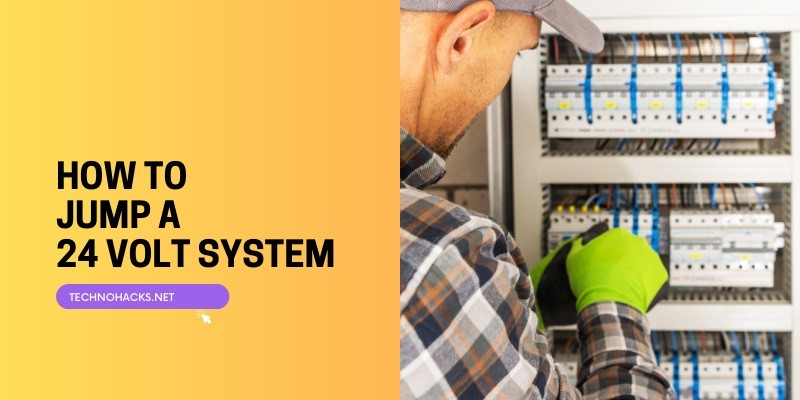Last Updated on May 5, 2025 by Jim C.
Jump-starting a 24-volt system can be a daunting task, especially for those who are more accustomed to dealing with standard 12-volt car batteries. However, understanding the correct procedures and safety measures can make the process straightforward and safe. This article will guide you through the steps required to jump-start a 24-volt system, commonly found in trucks, heavy machinery, and RVs.
Understanding 24-Volt Systems
A 24-volt system typically consists of two 12-volt batteries connected in series. This configuration doubles the voltage while maintaining the same capacity (amp-hours) as a single 12-volt battery. The positive terminal of the first battery is connected to the negative terminal of the second battery, creating a series circuit that provides 24 volts.
Why 24-Volt Systems?
24-volt systems are used in larger vehicles and machinery because they can deliver more power to start larger engines and run more demanding electrical systems. These systems are essential in applications where reliability and power are critical.
Safety Precautions
Before attempting to jump-start a 24-volt system, it is crucial to follow safety precautions to avoid injury or damage:
- Wear Protective Gear: Always wear gloves and safety glasses to protect yourself from sparks and battery acid.
- Clear the Area: Ensure the area is free of flammable materials.
- Turn Off Electrical Loads: Shut off all electrical components and isolators before starting the process.
- Check the Batteries: Inspect the batteries for any visible damage, leaks, or corrosion.
Required Tools and Equipment
To jump-start a 24-volt system, you will need the following tools and equipment:
- Jumper cables
- Voltmeter or multimeter
- Protective gear (gloves and safety glasses)
Step-by-Step Guide to Jump-Starting a 24-Volt System
Method 1: Using Two 12-Volt Batteries
Preparation
- Ensure Both 12-Volt Batteries Are Charged: Verify that both 12-volt batteries are fully charged using a voltmeter. Each battery should read around 12.6 volts when fully charged.
- Position the Batteries: Place the batteries close to the 24-volt system, ensuring they are stable and secure.
Connecting the Batteries
- Connect Positive Terminals: Attach the positive terminal of the first 12-volt battery to the positive terminal of the 24-volt system.
- Series Connection: Connect the negative terminal of the first 12-volt battery to the positive terminal of the second 12-volt battery.
- Complete the Circuit: Finally, connect the negative terminal of the second 12-volt battery to the negative terminal of the 24-volt system.
Starting the Engine
- Double-Check Connections: Ensure all connections are secure and correct.
- Start the Engine: Attempt to start the engine of the 24-volt system. If it does not start, recheck the connections and the charge of the batteries.
Method 2: Using a Single 12-Volt Battery (Emergency Method)
This method can be used in emergencies when only one 12-volt battery is available.
Preparation
- Ensure the 12-Volt Battery Is Fully Charged: Check the battery with a voltmeter to ensure it is fully charged.
- Position the Battery: Place the battery close to one of the 12-volt batteries in the 24-volt system.
Connecting the Battery
- Connect Positive Terminals: Attach the positive terminal of the 12-volt battery to the positive terminal of one of the 12-volt batteries in the 24-volt system.
- Connect Negative Terminals: Connect the negative terminal of the 12-volt battery to the negative terminal of the same 12-volt battery in the 24-volt system.
Starting the Engine
- Double-Check Connections: Ensure all connections are secure.
- Start the Engine: Attempt to start the engine of the 24-volt system. Note that this method may not always work if the batteries are too depleted.
Troubleshooting Tips
If the engine does not start, consider the following troubleshooting steps:
- Check Battery Charge Levels: Use a voltmeter to ensure the batteries are adequately charged.
- Secure Connections: Ensure all connections are tight and secure.
- Clean Terminals: Look for corrosion on the battery terminals and clean them if necessary.
Post-Jump-Start Procedures
After successfully jump-starting the 24-volt system, follow these steps:
- Disconnect Jumper Cables: Remove the jumper cables in the reverse order of connection.
- Run the Engine: Allow the 24-volt system to run for at least 15-20 minutes to recharge the batteries. Ideally, take the vehicle for a drive to ensure the alternator recharges the batteries effectively.
- Check the Charging System: Verify that the charging system is functioning correctly to prevent future battery issues.
Conclusion
Knowing how to jump-start a 24-volt system is a valuable skill, especially for those who operate heavy machinery, trucks, or RVs. By following the outlined steps and safety precautions, you can ensure a safe and successful jump-start. Regular maintenance and checks can help avoid the need for emergency jump-starts, ensuring your 24-volt system remains reliable.

